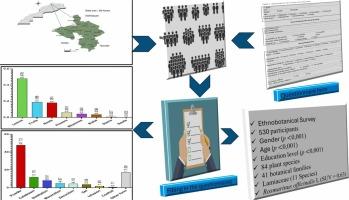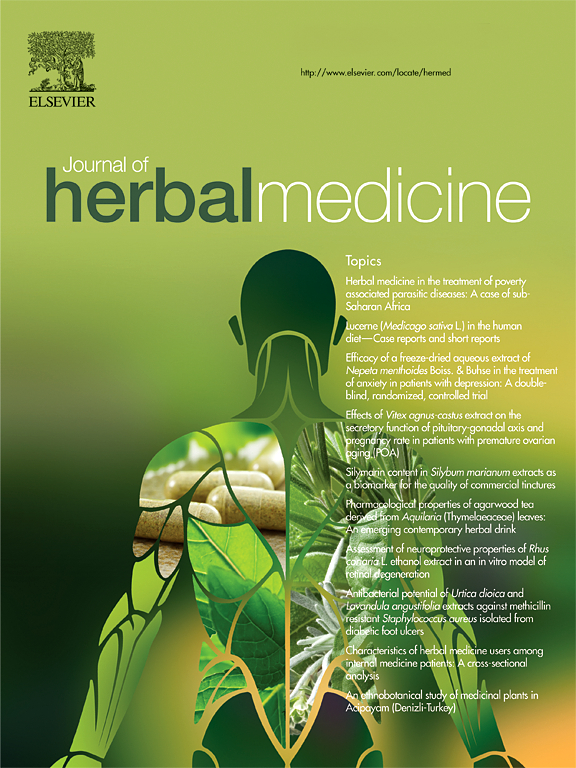Ethnobotanical study of plants used in treating skin ailments and dermato-cosmetics among population of Sidi Kacem, Northeast of Morocco
IF 1.9
4区 医学
Q2 INTEGRATIVE & COMPLEMENTARY MEDICINE
引用次数: 0
Abstract
Introduction
To address the threat of the disappearance of oral knowledge of traditional medicinal and cosmetic plants, an ethnobotanical study of plants used in treating skin diseases and dermato-cosmetics was carried out in the Sidi Kacem region.
Methods
A total of 530 local residents took part in the study. The method adopted was based on semi-structured interviews with open-ended questions. The data collected were analysed using basic statistical tools and quantitative indices such as use value of botanical family (FUV), species use value (SUV), Fidelity level (FL), informant agreement ratio (IAR) and part of the plant value (PPV).
Results
A total of 84 plant species in 41 botanical families were recorded, with a marked predominance of the Lamiaceae family, represented by 11 species (FUV = 0,18). Among these plants, Rosmarinus officinalis L. has the highest use value (SUV = 0,63). In terms of conditions treated, cosmetic uses and viral infections have the highest index of informant agreement ratio (IAR = 0,97). The maximum fidelity level reached 100, indicating a high degree of consistency in plant use. Leaves are the most frequently used part (PPV = 0,478), while powder form is the most common method of preparing remedies.
Discussion/Conclusion
The survey highlighted the diversity of plant species and the strength of traditional knowledge associated with medicinal and cosmetic plants. Based on these results, the researchers encourage the scientific community to further investigate the phytochemical and pharmacological properties of local medicinal plants.
Data and model availability statement
The datasets used and/or analyzed during the current study are available in the manuscript.

摩洛哥东北部Sidi Kacem人群中用于治疗皮肤病和皮肤化妆品的植物的民族植物学研究
为了解决传统药用和化妆品植物口头知识消失的威胁,在Sidi Kacem地区对用于治疗皮肤病和皮肤化妆品的植物进行了民族植物学研究。方法共有530名当地居民参与了研究。所采用的方法是基于带有开放式问题的半结构化访谈。采用植物科利用价值(FUV)、物种利用价值(SUV)、保真度水平(FL)、知情同意率(IAR)和部分植物价值(PPV)等基本统计工具和定量指标对收集到的数据进行分析。结果共记录到41科84种植物,其中Lamiaceae占优势,有11种(FUV = 0,18)。其中,利用价值最高的是迷迭香(Rosmarinus officinalis L.) (SUV = 0,63)。在治疗条件方面,化妆品使用和病毒感染具有最高的知情同意比指数(IAR = 0.97)。最高保真度达到100,表明植物使用的一致性很高。叶子是最常用的部分(PPV = 0,478),而粉末形式是制备补救措施的最常用方法。讨论/结论该调查突出了植物物种的多样性和药用和化妆品植物相关的传统知识的力量。基于这些结果,研究人员鼓励科学界进一步研究当地药用植物的植物化学和药理特性。数据和模型可用性声明当前研究中使用和/或分析的数据集可在手稿中获得。
本文章由计算机程序翻译,如有差异,请以英文原文为准。
求助全文
约1分钟内获得全文
求助全文
来源期刊

Journal of Herbal Medicine
INTEGRATIVE & COMPLEMENTARY MEDICINE-
CiteScore
3.90
自引率
0.00%
发文量
94
期刊介绍:
The Journal of Herbal Medicine, the official journal of the National Institute of Medical Herbalists, is a peer reviewed journal which aims to serve its readers as an authoritative resource on the profession and practice of herbal medicine. The content areas of the journal reflect the interests of Medical Herbalists and other health professionals interested in the clinical and professional application of botanical medicines. The objective is to strengthen the research and educational base of herbal medicine with research papers in the form of case studies, original research articles and reviews, monographs, clinical trials and relevant in vitro studies. It also publishes policy statements, opinion pieces, book reviews, conference proceedings and profession related information such as pharmacovigilance reports providing an information source for not only the Herbal Practitioner but any Health professional with an interest in phytotherapy.
 求助内容:
求助内容: 应助结果提醒方式:
应助结果提醒方式:


